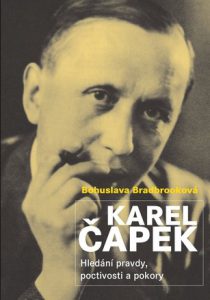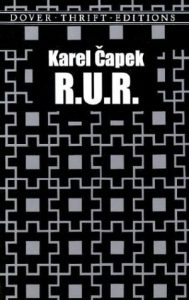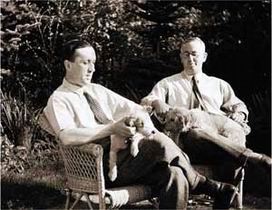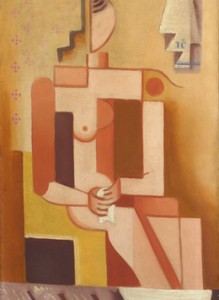The artistic genius of Karel and Josef Čapek
By Tracy A. Burns
Karel Čapek’s personal life from birth to student days
 Perhaps the most versatile and prominent writer in Czech history, Karel Čapek was well-known as a playwright, novelist, story writer, journalist, children’s author, biographer, essayist, illustrator, photographer, and translator. The prolific scribe was born in northeast Bohemia’s mining town Malé Svatoňovice on January 9, 1890, as the youngest of three children – he had a sister named Helena (born in 1886) and a brother named Josef (born in 1887), with whom he often collaborated on his writings in the early years. His father Antonín was a spa doctor, and his mother Božena had been raised in a rural mill. Soon the family of five moved to nearby Úpice. Karel attended high school in eastern Bohemia’s Hradec Králové but had to complete his studies in the Moravian capital of Brno because he had started a group that did not look favorably at Austrians during an era where the Czech lands were part of the Austro-Hungarian Empire. After earning a doctorate in philosophy and esthetics from Prague’s Charles University, he continued his studies in Berlin and Paris.
Perhaps the most versatile and prominent writer in Czech history, Karel Čapek was well-known as a playwright, novelist, story writer, journalist, children’s author, biographer, essayist, illustrator, photographer, and translator. The prolific scribe was born in northeast Bohemia’s mining town Malé Svatoňovice on January 9, 1890, as the youngest of three children – he had a sister named Helena (born in 1886) and a brother named Josef (born in 1887), with whom he often collaborated on his writings in the early years. His father Antonín was a spa doctor, and his mother Božena had been raised in a rural mill. Soon the family of five moved to nearby Úpice. Karel attended high school in eastern Bohemia’s Hradec Králové but had to complete his studies in the Moravian capital of Brno because he had started a group that did not look favorably at Austrians during an era where the Czech lands were part of the Austro-Hungarian Empire. After earning a doctorate in philosophy and esthetics from Prague’s Charles University, he continued his studies in Berlin and Paris.
From journalism to marriage
He was exempted from fighting in World War I due to a spinal injury and served as a tutor for a noble family for three months before becoming a journalist. This highly acclaimed author worked with several newspapers before joining the liberal Lidové Noviny in 1921, for which he would write until his death in 1938. An influential playwright, he also worked as dramaturg and director for the Vinohrady Theatre from 1921 to 1923 and chaired Czechoslovakia’s PEN Club from 1925 to 1933. In August of 1935 at the age of 45, he finally married his long-time girlfriend, actress, and writer Olga Sheinpflugová.
Karel Čapek’s writing styles
Karel had mastered the Czech language, utilizing a vast vocabulary utilized in his writings. He also employed many uncommon words and colloquial Czech without vulgarisms. In his works, he asserted that each person has his or her own truth, portrayed many perspectives on reality, and criticized modern society. An avid supporter of democracy, he also expressed fears of Fascism. People’s abuse of technology was another theme that often came up in his writings that appear simple but are really profound with many layers of meaning. Karel often wrote about everyday occurrences and ordinary people, finding joy in commonplace events. He translated an anthology of French poetry in the early 1920s. This ingenious author also penned hundreds of feuilletons, articles about everyday events seen from a comical perspective. His most prominent children’s book, Dashenka or The Life of a Puppy from 1932, is a sort of fairy tale that captured much attention in the realm of children’s literature. Karel also wrote fairy tales, in which the protagonists are sincere, common people.
Travelogues and political writings
Karel Čapek’s travelogues relay his experiences in other countries with vivid descriptions and keen observations. His Letters from Italy (1923) focus on Italian art and landscape. In his travelogues from England (1924), he concentrates on the English countryside and people’s behavior. His writings about Scandinavia (1936) describe awe-inspiring nature. Karel filled that book with 250 of his own drawings. He also wrote about his visits to Spain (1930) and to Holland (1932). Karel was close friends with the first president of Czechoslovakia, Tomáš G. Masaryk. His conversations with Masaryk during seven years, titled Talks with T.G. Masaryk (1928-35), focus on the president’s life and philosophy on many topics.
Karel Čapek’s prose
His first book of stories, The Wayward Crosses (1921), focuses on the irrational. For example, one character finds one footprint in the otherwise pristine snow. The Absolute at Large (1922) is concerned with a revolutionary invention and its consequences. Inventor Marek splits an atom to obtain extraordinary amounts of energy but also finds out that the process has a side effect: it makes people obsessed with religion. Tales from One Pocket and Tales from the Other Pocket from 1928-29 feature mostly mysteries as each story expresses a different way of discovering reality. From 1932 to 1934 he wrote the trilogy of Hordubal, Meteor, and An Ordinary Life. Meteor centers around a plane crash casualty in a coma with an unknown identity. Two patients and a muse make up stories about the mysterious man. In War with the Newts (1936), an anti-Fascist novel, Karel describes how entrepreneur Bondy breeds, sells, and exploits newts to work in the sea. The newts rebel and threaten humanity. In this work Karel also satires material success and the ideals of wealth.
Karel Čapek’s dramas
 Perhaps R.U.R. (1920) is best known for first using the word “robot,” coined by brother Josef. In this drama about a man abusing technology, Rossum’s factory R.U.R makes robots on an island. The robots revolt and murder all humans except for one man whom they order to find the secret formula of their existence, without which they can longer live. In From the Life of Insects (1921), also written with Josef, the insects in the play represent basic negative human traits, such as snobbery, selfishness, and cruelty. In the third section, war erupts in a country of ants, and Karel takes an anti-military stance, demonstrating that the objectives of war are futile. The Makropulos Thing (1922) was Karel’s next drama. Its protagonist, singer Emilia Marty, reveals she is 300 years old. Her father was an alchemist for Emperor Rudolf II and tried out the elixir of eternal youth on her. She needs to find the document containing the potion’s secret formula in order to continue living. Here Karel argued that people should make the most of the brief time they are on the earth rather than desire longevity. In The White Plague ( 1937) a horrific disease like leprosy is killing people in a totalitarian society. The dictator gets the disease, and Dr. Gallen, who has found the cure, agrees to give it to him if he will bring peace to the country. On his way to give the Marshall the injection, a crowd showing their support for the dictator kills Dr. Gallen, and war breaks out. The Mother (1938) centers around a mother whose four sons and husband have fallen in war. Her youngest son yearns to serve his country, but his mother does not want him to die. When she hears that the enemy is murdering children, she changes her opinion and urges her son to join the troops.
Perhaps R.U.R. (1920) is best known for first using the word “robot,” coined by brother Josef. In this drama about a man abusing technology, Rossum’s factory R.U.R makes robots on an island. The robots revolt and murder all humans except for one man whom they order to find the secret formula of their existence, without which they can longer live. In From the Life of Insects (1921), also written with Josef, the insects in the play represent basic negative human traits, such as snobbery, selfishness, and cruelty. In the third section, war erupts in a country of ants, and Karel takes an anti-military stance, demonstrating that the objectives of war are futile. The Makropulos Thing (1922) was Karel’s next drama. Its protagonist, singer Emilia Marty, reveals she is 300 years old. Her father was an alchemist for Emperor Rudolf II and tried out the elixir of eternal youth on her. She needs to find the document containing the potion’s secret formula in order to continue living. Here Karel argued that people should make the most of the brief time they are on the earth rather than desire longevity. In The White Plague ( 1937) a horrific disease like leprosy is killing people in a totalitarian society. The dictator gets the disease, and Dr. Gallen, who has found the cure, agrees to give it to him if he will bring peace to the country. On his way to give the Marshall the injection, a crowd showing their support for the dictator kills Dr. Gallen, and war breaks out. The Mother (1938) centers around a mother whose four sons and husband have fallen in war. Her youngest son yearns to serve his country, but his mother does not want him to die. When she hears that the enemy is murdering children, she changes her opinion and urges her son to join the troops.
The year 1938 and Karel Čapek’s death
In 1938 after the Munich Agreement that ceded Czechoslovakia’s Sudetenland to the Third Reich, many people favored Communism and belittled democracy, which Karel promoted so fervently. Closely associated with Masaryk’s first democratic republic, Karel was the recipient of many threats and anonymous letters. He died of double pneumonia, deeply distraught over the Munich Agreement and over his enemies in his homeland, on Christmas Day, 1938, not long before the Gestapo would have probably arrested him for his anti-Nazi proclamations and shortly before his 49th birthday. His grave is among the resting places of many well-renowned Czechs at Prague’s Vyšehrad Cemetery.
Josef Čapek: from Hronov to Prague
Three years older than Karel and the middle child, Josef Čapek made a name for himself as a painter, writer, photographer, graphic artist, and book illustrator. Born March 23, 1887, in northeast Bohemia’s Hronov near the Polish border, he spent his childhood in Malé Svatoňovice and nearby Úpice. Josef attended a German weaving school for two years before working in a factory. In 1904 he moved to Prague to study at a decorative arts school. After traveling through France and Spain, he returned to Prague, where he published art reviews, theoretical essays, and other articles in various newspapers.
Josef Čapek teams up with Karel
 The budding author served as editor of Umělecký měsíčník, a publication for the Visual Artists’ Group, of which he was a member. Then he edited the Mánes Society’s Volné směry. During the initial years of his writing career, he teamed up with Karel on six works. He and Karel contributed to the Almanac of 1914. First, they cooperated on The Luminous Depths (1916); then the prosaic Krakonoš Garden (1918) the allegorical drama From The Life of Insects (1922), and the utopian Adam The Creator (1927). While helping his brother pen the drama R.U.R, he coined the word “robot.” The brothers were very close. They lived together for a time. When Josef was let go from the Národní listy newspaper, Karel left, too. His younger brother accepted the post with Lidové Noviny on the condition that Josef could also contribute to the daily. Josef wrote for Lidové Noviny from 1921 to 1939.
The budding author served as editor of Umělecký měsíčník, a publication for the Visual Artists’ Group, of which he was a member. Then he edited the Mánes Society’s Volné směry. During the initial years of his writing career, he teamed up with Karel on six works. He and Karel contributed to the Almanac of 1914. First, they cooperated on The Luminous Depths (1916); then the prosaic Krakonoš Garden (1918) the allegorical drama From The Life of Insects (1922), and the utopian Adam The Creator (1927). While helping his brother pen the drama R.U.R, he coined the word “robot.” The brothers were very close. They lived together for a time. When Josef was let go from the Národní listy newspaper, Karel left, too. His younger brother accepted the post with Lidové Noviny on the condition that Josef could also contribute to the daily. Josef wrote for Lidové Noviny from 1921 to 1939.
Standing on his own
Yet he did not always write to his brother. Josef’s other works include the play The Land of Many Names (1923), which Karel directed at Prague’s Vinohrady Theatre. He also penned the mystery prose The Shadow of the Fern (1930) and a meditation about the world with quotations from The Old Testament and Shakespeare called The Limping Pilgrim (1936) His art-related books The Art of Indigenous Peoples and The Humblest Art are ingenious, and his children’s book The Tale of Doggie and Moggie remains a favorite to this day. His diaries from 1936-1939 were published posthumously as was his poetry scribed in concentration camps.
Josef Čapek the painter
 As a painter, he was entranced with Cubism and modern art in general. His first paintings appeared in Prague in 1912. In 1914 his Cubist creation “Swimmer” featured clearly delineated and simplistic half-length figure. He became a member of the Tvrdošíjní (The Obstinate Ones) group, and many of his paintings, drawings, linocuts, and lithographs were shown at The Obstinate Ones’ exhibitions. He employed simple, geometric shapes, presenting everyday things with philosophical subtexts in a spiritual and mystical manner. Josef utilized severe lighting contrasts, which created a dynamic tension. He was greatly influenced by “primitive” art, and his visions captured a naïve reality. He also often painted themes from the city periphery and still lifes from ordinary objects. Art buffs in Berlin were able to see his works in 1921. During the late 1920s, he often used beggars and members of the lower class who looked suspicious or dangerous as his subjects. From 1910 to 1924 he created 106 oil paintings plus 116 tempera, watercolors, drawings, graphics, and book covers.
As a painter, he was entranced with Cubism and modern art in general. His first paintings appeared in Prague in 1912. In 1914 his Cubist creation “Swimmer” featured clearly delineated and simplistic half-length figure. He became a member of the Tvrdošíjní (The Obstinate Ones) group, and many of his paintings, drawings, linocuts, and lithographs were shown at The Obstinate Ones’ exhibitions. He employed simple, geometric shapes, presenting everyday things with philosophical subtexts in a spiritual and mystical manner. Josef utilized severe lighting contrasts, which created a dynamic tension. He was greatly influenced by “primitive” art, and his visions captured a naïve reality. He also often painted themes from the city periphery and still lifes from ordinary objects. Art buffs in Berlin were able to see his works in 1921. During the late 1920s, he often used beggars and members of the lower class who looked suspicious or dangerous as his subjects. From 1910 to 1924 he created 106 oil paintings plus 116 tempera, watercolors, drawings, graphics, and book covers.
Speaking out against Fascism and designs for the theatre
A supporter of democracy like his brother, Josef spoke out boldly against Fascism in his articles and artwork. In the late 1930s, he also received more worldwide recognition as his artistic creations were displayed in London and in Pittsburgh. His last painting cycles of Fire and Longing remain among his best. He also often designed book covers, producing 150 up to 1938, and illustrated some of Karel’s books. The plays featuring his scene and costume designs include From the Life of Insects as green and black stylized vegetation dominated the ant segment. The costumes of the insects were poignantly grotesque.
Josef Čapek’s last years
This gifted writer and painter was arrested by the Gestapo on September 1, 1939, for his anti-Fascist stance and spent six years in concentration camps. That did not stop him from writing, though. He secretly translated poetry and authored his own poems. On February 25, 1945, he was transported to Bergen-Belsen in the midst of a typhoid epidemic. Josef Čapek died in April, shortly before the Germans lost the war. His symbolic grave is at Prague’s Vyšehrad Cemetery, where his brother is buried.




